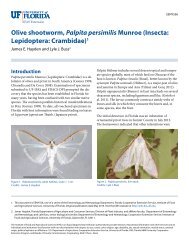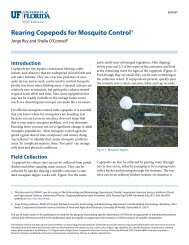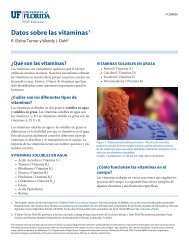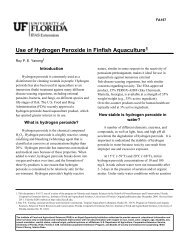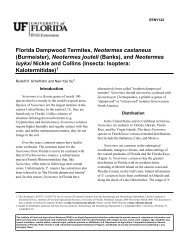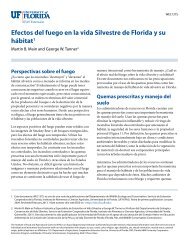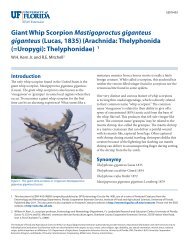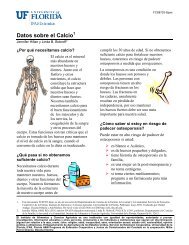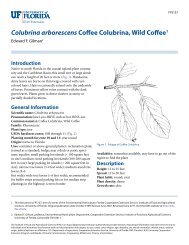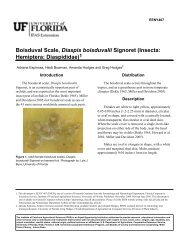Puss Caterpillar (Larva), Southern Flannel Moth (Adult ...
Puss Caterpillar (Larva), Southern Flannel Moth (Adult ...
Puss Caterpillar (Larva), Southern Flannel Moth (Adult ...
Create successful ePaper yourself
Turn your PDF publications into a flip-book with our unique Google optimized e-Paper software.
The family name Megalopygidae and genus name Megalopyge<br />
are derived from the Greek roots Megalo (large) and<br />
pygidium (rump)—probably because of the shape of the<br />
caterpillars. The specific epithet, opercularis, is derived from<br />
the Latin word operculum (Borror 1960) and refers to the<br />
lid (door) on the cocoon. The name “puss caterpillar” is<br />
likely in reference to the caterpillar’s resemblance to a cat<br />
with its soft fur and tail.<br />
The southern flannel moth was originally described by J. E.<br />
Smith (1797) and named Phalaena opercularis (common<br />
name, waved yellow egger moth). For a historical account of<br />
the southern flannel moth’s taxonomy see Heppner (2003).<br />
In addition to the name “puss caterpillar”, its caterpillar has<br />
been called “Italian asp,” “possum bug,” “perrito” (Spanish<br />
for puppy or little dog) (Bishopp 1923), and “woolly slug”<br />
(El-Mallakh et al. 1986).<br />
The southern flannel moth is one of three species of<br />
megalopygids in the eastern United States. For photos and<br />
general information on the other two: the black-waved<br />
flannel moth, Megalopyge (=Lagoa) crispata (Packard), and<br />
the white flannel moth, Norape ovina (Sepp), see Covell<br />
(2005) and Wagner (2005). For more detailed information<br />
on the biology of the black-waved flannel moth, see Lintner<br />
(1869) and Packard (1894).<br />
Distribution<br />
The southern flannel moth is found from Maryland to<br />
Florida and west to Missouri and Texas (Covell 2005). It is<br />
common in Florida but reaches its greatest abundance in<br />
Texas from Dallas southward in the western central part of<br />
the state (Bishopp 1923).<br />
Description<br />
<strong>Adult</strong>s: <strong>Adult</strong>s are small moths with wingspans of 2.4 to<br />
3.6 cm (approximately 1 to 1.5 in) (Covell 2005). Females<br />
are larger than males. The front wings are yellow with some<br />
black along the costal margins and waves of white hair-like<br />
setae (scales) on the basal 2/3 of the wings. Khalaf (1984)<br />
demonstrated that the hair-like setae are actually deeply<br />
divided scales and that the undivided bases of the scales<br />
are typical of wing scales of other moths. The black color<br />
is more pronounced in males. Hind wings of both sexes<br />
are uniformly creamy-yellow. The common name “flannel<br />
moth” is due to the thick coating of fur-like setae on the<br />
bodies which is predominantly orange on the thorax.<br />
Figure 4. Male southern flannel moth, Megalopyge opercularis<br />
(anterior view).<br />
Credits: Donald W. Hall, University of Florida.<br />
Figure 5. <strong>Adult</strong> female southern flannel moth, Megalopyge opercularis<br />
(anterior view).<br />
Credits: Donald W. Hall, University of Florida.<br />
Antennae are bipectinate (comb-like) with rami (teeth) on<br />
two sides. Rami of antennae of males (Figures 1, 2, and 4)<br />
are much longer than those of antennae of females (Figures<br />
3 and 5). The rami of the antennae of females are so short<br />
that the antennae appear almost thread-like.<br />
Figure 6. Female and male southern flannel moths, Megalopyge<br />
opercularis.<br />
Credits: Donald W. Hall, University of Florida.<br />
2



